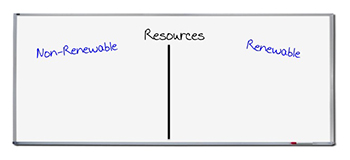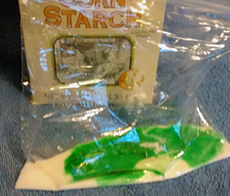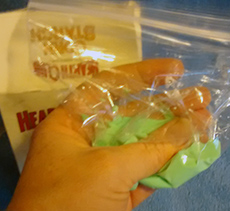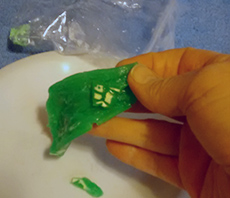Agricultural Literacy Curriculum Matrix
Lesson Plan
Corn an A-maizing Plant: Food, Fuel, and Plastic
Grade Level
Purpose
Students examine the growth, composition, history, and uses of corn through a close reading activity, discussion of renewable and non-renewable resources, and hands-on exploration of bioplastics made from corn. Grades 3-5
Estimated Time
Materials Needed
Engage:
Activity 1: A Brief History of Corn
- United States Map
- A Brief History of Corn information sheet
- A Golden Nugget slideshow
- 360° Farm Tour: Harvesting the Corn
Activity 2: Renewable vs Nonrenewable Resources
Activity 3: Making Bioplastic
- 10 Styrofoam packing peanuts*
- 10 biodegradable packing peanuts*
- 2 sandwich-size resealable plastic bags
- Physical and Chemical Change slideshow
- Sandwich-size resealable plastic bags, 1 per group
- Cornstarch, 1 tablespoon (14 g) per group
- Corn oil, 2 drops per group
- Water, 1 tablespoon (15 mL) per group
- Food coloring, 2 drops per group
- Tablespoons, 1 per group
- Bioplastic activity sheet
*These items are included in the Packing Peanuts Kit, which is available for purchase from agclassroomstore.com.
Vocabulary
biodegradable: capable of being broken down through the actions of living organisms and natural processes over time
bioplastics: a group of plastics made from biological materials like plant starches, cellulose, oils, or protein
bushel: a unit of measurement used in US agriculture that is equivalent to a volume of 64 pints, but is generally standardized by weight for different products; a bushel of wheat weighs 60 lbs, a bushel of corn weighs 56 lbs
by-product: an incidental or secondary product made in the manufacture or synthesis of something else
compostable: capable of breaking down through the actions of living organisms in specific conditions to a defined outcome; generally, the conditions are moist, warm, and aerobic, and the end product is non-toxic compost that can enhance soil and support plant growth
Corn Belt: the area of the United States where corn is the predominant crop grown
endosperm: tissue formed within a seed that contains energy (starch) and protein for the germinating seed
germ: the embryo of a cereal grain seed
nonrenewable resource: limited natural resource that cannot be replaced or reproduced within a generation and cannot be managed for renewal; examples include oil, soil, mineral resources (lead, iron, cobalt, zinc, etc.)
pericarp: the outer, protective covering of the corn kernel
recyclable: capable of being recycled
renewable resource: natural resource that can be replaced naturally or by human efforts at a sustainable rate; examples include forests, fish, wildlife, plants, animals
Did You Know?
- In 2015, US corn growers produced an average of 168 bushels per acre.2
- An average ear of corn has 800 kernels, and there are approximately 72,000 kernels in one bushel of corn.3
- One bushel of corn provides: 31.5 lbs (14.2 kg) of starch or 33 lbs (15 kg) of sweetener or 2.8 gallons (10.6 L) of ethanol.3
Background Agricultural Connections
The Corn Belt is a region of the United States where corn is the predominant crop grown. Iowa and Illinois are the top corn-producing states, and they typically grow just over one-third of the US crop. Other major states for corn production include Nebraska, Minnesota, Indiana, Wisconsin, Michigan, South Dakota, Kansas, Missouri, Kentucky, and Ohio. These twelve states can be considered part of the Corn Belt. Corn is planted in the spring and harvested in the fall. Warm, rainy summers and deep, fertile soils make the Corn Belt region particularly well suited for growing corn.
An ear of corn has an average of sixteen rows with 800 kernels. There are approximately 1300 kernels in one pound of corn. An acre (about the size of a football field) of corn can yield more than 13 million kernels. In the United States, corn production is commonly measured in bushels. This measurement originated as a unit of volume but has been standardized to units of weight for different commodities. One bushel of shelled corn is equivalent to 56 pounds (25 kg).
First domesticated in Mexico, corn is now grown on every continent of the world except Antarctica. The United States produces more corn than any other country. The scientific name for corn is Zea mays. All types of corn belong to this species, including sweet corn, popcorn, dent (field) corn, flour corn, and flint corn. Dent corn is the type most widely grown and processed in the United States. Hybrids of corn, produced by crossbreeding different varieties, have been developed to grow well in varying conditions and locations worldwide. The development of hybrid varieties, along with synthetic fertilizers and new farm machinery, has facilitated huge increases in corn productivity. Today, more corn can be grown on less land than ever before.
Similarly, advances in technology allow us to use more components of the processed corn kernel than ever before. One hundred years ago, starch was the main product used from refined corn, while the rest of the kernel was thrown away. Today, there are uses for every part of the kernel—even the water in which it is processed. The corn seed (kernel) is composed of four main parts: the endosperm, the pericarp, the germ, and the tip cap. The endosperm makes up most of the dry weight of the kernel and provides the source of energy for the seed. The pericarp is the hard, outer coat that protects the kernel both before and after planting. The germ is the living embryo of the corn kernel. It contains genetic information, vitamins, and minerals that the kernel needs to grow. The tip cap is where the kernel is attached to the cob and is the major entry path into the kernel for water and nutrients.
Corn is a versatile crop. It is the major grain grown for livestock feed by farmers in the United States, leading all other feed crops in value and volume of production. Corn is a major component in foods like cereals, peanut butter, and snack foods, and it is also processed into a wide range of industrial products, including ethanol. The kernel is used as oil, bran, starch, glutamates, animal feed, and solvents. The silk is combined with other parts of the corn plant to be used as part of animal feed, silage, and fuels. Husks are made into dolls and used as filling materials. The stalk is used to make paper, wallboard, silage, syrup, and rayon (artificial silk).
Corn can also be used to make a type of plastic known as bioplastic. Commonly, plastic is made from petroleum, a fossil fuel that is a nonrenewable resource. In contrast, bioplastic is made from biological materials—plant starches, cellulose, oils, or proteins. Unlike petroleum-based plastics, bioplastics are made from renewable resources such as corn, potatoes, tapioca, and casein (milk protein). One example of a bioplastic application is packing peanuts—the loose fill that goes all over when you open a package. Some packing peanuts are made of polystyrene (Styrofoam), which is a petroleum-based plastic. Corn-based packing peanuts are made of over 99% cornstarch and a very small percentage of food-grade oil. These packing peanuts are non-toxic, biodegradable, and compostable.
Teach for ClarityIt is important to note that there are pros and cons to both bioplastics and petroleum-based plastics. There are also some common misconceptions about the differences between these groups of plastics. For example, both bioplastics and petroleum-based plastics can be biodegradable, meaning that over time they break down into compounds like carbon dioxide, water, and methane when exposed to naturally occurring microorganisms like bacteria, fungi, and algae.1 Also, some bioplastics are recyclable.1 The ability of a plastic to be recycled or to biodegrade depends on the chemical structure of the plastic, not whether the plastic is made from renewable or nonrenewable materials. In addition, many people are unaware that the raw materials used to make petroleum-based plastics are the by-products of refining crude oil for fuel. If these by-products were not used to make plastics, they would be industrial waste that would need to be disposed of. For more information, see the segment from D News, The Truth About Biodegradable Plastic. For more information about corn, see the National Corn Growers Association website and Iowa Corn's Corn Facts webpage. |
Engage
- Provide each student with the Corn/Corn-Free Product List and project the photograph of the corn and corn-free products on the classroom screen. Explain that every item on the list is shown in the photograph. Ask the students to circle each item on the list that they think contains corn.
- After the students have finished circling the items, tell them that only one of the items does not contain corn. Ask the students to tell you which item they think does not contain corn.
- Reveal to the class that the only item on the list that does not contain corn is the pasta. It contains wheat flour, not corn flour. Refer to the list below to explain what form of corn each remaining item contains.
- Aspirin – cornstarch
- Baking Powder – cornstarch
- Batteries – cornstarch (insulation)
- Bubble Gum – corn syrup
- Coke – corn syrup
- Corn Tortillas – corn flour
- Crayons – corn oil
- Crunch Berries – corn syrup
- Diaper – cornstarch
- Gain Detergent – cornstarch
- Matches – cornstarch (match head)
- Pasta – does not contain corn
- Shoelaces – cornstarch (for smooth tying)
- Snickers Bar – corn syrup
- Show students the Corn Information Sheet. Explain that corn is not only used in food products but also in many non-food items we use every day.
Explore and Explain
Activity 1: A Brief History of Corn
- Provide each student with a copy of the A Brief History of Corn handout. Have students do a close reading of the text. For more information about the close reading strategy, refer to the resource guide Supporting Students in Close Reading.
- Using the map of the United States, have students identify and highlight the states that are part of the Corn Belt—Iowa, Illinois, Nebraska, Minnesota, Indiana, Wisconsin, Michigan, South Dakota, Kansas, Missouri, Kentucky, and Ohio. Explain to the students that the warm, rainy summers and deep, fertile soils in this region of the United States are particularly well suited for growing corn.
- Use the A Golden Nugget PowerPoint slides to discuss the different types of corn plants and their uses, the structure of a corn kernel, and the functions of each part of the kernel.
- Show the 360° Farm Tour: Harvesting the Corn video to take a tour through the seasons of planting, growing, and harvesting corn.
- Using the information from the Background Agricultural Connections, discuss the uses of corn. Use the following questions to guide the discussion:
- Who used corn in ancient times?
- What are some of the ways corn is used today?
- Where is most of the corn grown in the United States?
- How have the uses of corn changed over time?
- What are the parts of the corn kernel called, and how are these parts useful?
Activity 2: Renewable vs. Nonrenewable Resources
- Write the word “Resources” on the center of the white board. Discuss what kinds of resources are essential to our everyday lives. We use many resources to provide our basic needs—food, water, shelter, and clothing.
- Write the word “Nonrenewable” on one side of the board and “Renewable” on the other side. Discuss the definitions of each word.
- Nonrenewable resources are made naturally by the earth but do not renew themselves fast enough for people to count on having the resource for an indefinite period of time. Some resources are considered nonrenewable because access to the resource is limited. For example, glass and metal are nonrenewable resources. The elements and minerals used to make glass and metal are found in the structure of the earth's crust, but we are limited to what we can access through mining.
- Renewable resources are either naturally reproduced at a sustainable rate or they can be produced in agriculture at a rate equivalent to the demand or need. For example, corn can be used for ethanol fuel, and a new crop of corn can be grown and harvested each year. Corn is a renewable resource.

- Divide the students into ten groups and give each group one of the Renewable vs. Nonrenewable cards. Each of these cards represents something that we use in our day-to-day activities. Ask each group to read their card and determine if the resource is renewable or nonrenewable. Once they have decided, they should place their card on the appropriate side of the board.
- Nonrenewable: gasoline, plastic, glass, metal
- Renewable: energy from the wind, energy from the sun, biodiesel, paper, food, and clothing
- Discuss the placement of the cards as a class. Emphasize that renewable resources are often grown or produced by farmers in a relatively short amount of time. Most nonrenewable resources are produced naturally by or in the earth. They can take thousands of years to form.
- Pick up or point to the “Plastic” card, which should be on the nonrenewable side of the board. Transition to the next activity by telling students that there is a method of making plastic that can be renewable.
Activity 3: Making Bioplastic
- Introduce the word “bioplastic” by writing it on the board and breaking it into two parts. “Bio” means that it comes from a living thing. “Bioplastic” is plastic that comes from a living thing.
- Place ten Styrofoam packing peanuts and ten biodegradable packing peanuts into two separate sandwich-size resealable bags. Add one cup of water to each bag, seal tight, and shake. The biodegradable peanuts will dissolve in less than ten seconds, while the Styrofoam will remain unchanged. Refer to the Physical and Chemical Change PowerPoint slides to discuss the physical change that takes place when the biodegradable packing peanuts dissolve in water.
- Explain to the students that the biodegradable packing peanuts are made of over 99% cornstarch and a small amount of food grade oil. The Styrofoam packing peanuts are made from petroleum. As a class, discuss the pros and cons of the two types of packing peanuts.
- Explain to the students that they will be making another type of bioplastic out of materials that come from the corn plant. Divide the class into groups of 4-5 students. Provide each student with a copy of the Making Bioplastic activity sheet and a resealable sandwich-size plastic bag. Give each group cornstarch, corn oil, water, and food coloring.

- To make the bioplastic, have the students combine 1 tablespoon (14 g) of cornstarch, 2 drops of corn oil, 1 tablespoon (15 mL) of water, and 2 drops of food coloring in the plastic bag.
- Instruct students to seal the bag and mix the ingredients by rubbing the outside of the bag with their fingers until the ingredients are thoroughly combined.

- Open the bag slightly, making sure it can vent, and place it into a microwave oven on high for 20-25 seconds.

- Carefully remove the bag from the microwave, and let it cool for a few minutes. While it is still warm, allow the students to form their plastic into a ball. Refer to the Physical and Chemical Change PowerPoint slides to discuss the chemical change that occurs when the bioplastic is made.

- Ask the students to complete the Making Bioplastic activity sheet and then discuss their observations as a class.
Elaborate
- Learn more about how petroleum-based plastic is made and recycled by watching the video From Oil to Plastic
- Make corn Johnnycakes in your classroom. The batter is simple to prepare and cooks quickly on an electric griddle.
- Watch the California Corn Harvest: Harvesting Sweet Corn by Hand video to learn more about sweet corn production.
- View the video Farm to Car to explore how plant-based plastics are being used in the automotive industry.
- Play the My American Farm interactive game Amazing Grains.
- Read Issue 5 Ag Today titled Agriculture in Society. This reader can be accessed digitally. Students will learn the term sustainability and what that means to farmers who need to produce 60% more food with the same amount of land in order to feed a growing world population. Learn what byproducts are and how they are used, how food packaging has decreased waste, and how farmers use technology such as various tools, robots, and hand-held devices to improve their efficiency.
- Watch the 3-minute "How Stuff Works" video clip about Corn Plastic.
Evaluate
- After conducting these activities, review and summarize the following key concepts:
- Corn is a versatile crop used for human consumption, livestock feed, and a wide range of industrial products, including bioplastics.
- Renewable resources can be replaced naturally or by human efforts at a sustainable rate.
- Bioplastics are made from renewable, biological materials produced on farms.
- To promote critical thinking, ask students, "Is corn plastic better than plastic made from petroleum-based products?" Allow students to offer their ideas. Consider showing the D News segment, The Shocking Truth About Biodegradable Plastics to stimulate thought.
|
Refer to the information found in the Background Agricultural Connections section of the lesson to help guide this discussion. Be sure students recognize that while corn plastic is made from a renewable resource, there are still pros and cons to its use. Point out to students that scientists will be needed to help discover new and improved solutions to challenges surrounding the use of natural resources, the best methods of recycling, and the reduction of waste in our landfills and oceans. |
Sources
- https://www.bpiworld.org/resources/documents/washington%20state%20biobased%20fact%20sheet%20aug%2014.pdf
- http://www.usda.gov/nass/PUBS/TODAYRPT/cropan16.pdf
- https://www.agintheclassroom.org/media/cdqd0zrk/corn-agmag-interactive.pdf
Acknowledgements
The bioplastic or corn plastic activity has been part of numerous presentations and published informally by several Agriculture in the Classroom programs and agricultural science programs. The original source for the bioplastic mixture is unknown.
Recommended Companion Resources
- A True Book: Corn
- Ag Today
- Better Paper, Plastics with Starch
- Carlos and the Cornfield
- Corn
- Crazy About Corn
- Eating the Plates
- Energy Island
- Engineering Everywhere: Bioplastics
- Evolution of Corn
- Farming in a Glove (Corn Seeds)
- Four Seasons of Corn: A Winnebago Tradition
- Get Popping!
- Grains Flowchart
- Grains and Legumes of the World
- Grains on MyPlate
- Harvesting for a Healthy Community Farm to School Resources
- How It's Made: Corn Tortillas
- How Stuff Works: Corn Plastic
- How Stuff Works: Popcorn
- If You Lived In Colonial Times
- In The Three Sisters Garden
- Let's Pop, Pop, Popcorn!
- Living Necklace Kits
- My American Farm
- My Family's Corn Farm
- My Family's Farm Book Series
- NASA Shows U.S. Corn Belt Literally Glowing with Productivity
- Packing Peanuts
- Popcorn Country: The Story of America's Favorite Snack
- Popcorn on the Cob
- Popcorn!
- Popped Secret: The Mysterious Origin of Corn
- Renewable vs Nonrenewable vs Inexhaustible Resources eMagazine
- Step into the Inca World
- The Popcorn Book
- Those Amazing Kernels of Corn!
- Three Sisters Seed Packet
- Tomatoes, Potatoes, Corn and Beans
Author
Organization
| We welcome your feedback! If you have a question about this lesson or would like to report a broken link, please send us an email. If you have used this lesson and are willing to share your experience, we will provide you with a coupon code for 10% off your next purchase at AgClassroomStore. |
